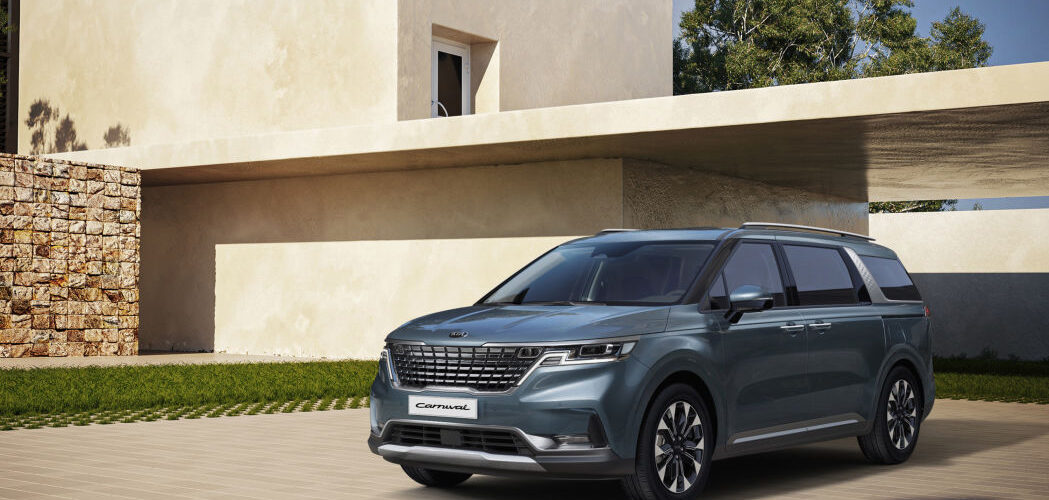In June, Kia first teased the exterior of the fourth-generation 2021 Carnival minivan for South Korea that we know as the Sedona, then it teased the interior. Today, the Asian automaker combines the photo sets with explanations about what Kia calls the new-generation “grand utility vehicle” — or as Car Advice calls it, “The ‘guv'” — will provide customers inside and out. The exterior aims for a more upscale SUV-ish look, with a longer hood and more upright A-pillar offsetting the reduced front overhang, and faux skid plates on the front and rear bumpers. The new take on the trademark “Tiger Nose” grille gets large-pore diagonal mesh within a chrome band that incorporates the super-slim headlights and LED running lights. Straight shoulder and lower character lines connect more pronounced wheel arches. Above that, black A- and B-pillars create what Kia calls an “island roof,” a hockey-stick C-pillar the only contrasting flourish between the floating upper and the body. In back, a full-width red light bar mimics the slim illumination in front.
That body sits on Kia’s new midsize platform and has grown in wheelbase by 1.2 inches, in overall length by 1.6 inches, 1.2 of that being rear overhang, and width gets an extra pip of 0.4 inches. Liftover height has been lowered an inch to make loading the family tackle easier, as do the power tailgate and power-sliding doors. There will be up to eight exterior paint choices, and wheel sizes ranging from 17 to 19 inches. Under that longer hood there will either be a gasoline direct-injected 3.5-liter V6 with 290 horsepower and 262 pound-feet of torque, a multi-port injected 3.5-liter V6 with 268 hp and 245 lb-ft, or a 2.2-liter four-cylinder diesel making 200 hp and 325 lb-ft. Since there’s no mention of a four-cylinder, the Sedona won’t follow the new Sorento’s lead. We expect one of those gas options over here, but we’re not sure which, and their outputs bracket the output from the current 3.3 liter that makes 276 hp and 248 lb-ft. A rotary shifter will control an eight-speed automatic in all trims.
Handling, ride, ambiance, and NVH improve thanks to a new fully independent suspension attached at some points with liquid-filled bushings to a new multi-skeletal cross-member. There’s more sound-deadening throughout the body, a covered underbody to reduce noise, and a reshaped intake to hush the engines. The old hydraulic steering retires, an EPAS unit on the column quickening the steering ratio and enabling more advanced driver assistance systems.
The larger body creates more room inside for people and cargo; depending on market, three- or four-row seating arrangements accommodate seven, nine or 11 people with more room for every occupant in every row. The revamped interior also provides nicer furnishings for everyone in every row. The star draw is the instrument panel, where Kia placed the 12.3-inch digital gauge cluster and 12.3-inch infotainment screen in a cohesive enclosure under a single pane of glass. A full-width horizontal band separates the upper and lower areas of the instrument panel, vents tucked discreetly into the contrasting divider. Below that, an LCD screen and dedicated haptic buttons offer radio and climate controls. There’ll be wireless Android Auto and Apple CarPlay in some markets, the ability to connect to smartphones via Bluetooth, and Kia Live services.
Second-row passengers in the seven-seat configuration get Premium Relaxation one-touch business-class seats with adjustable back-, arm-, and leg-rests, plus new USB outlets on the front seatbacks, nets to hold electronic devices, and a storage drawer at the base of the rear console. The front passengers will be able to check on those rear passengers without turning their heads thanks to a Rear Passenger View & Talk feature that pipes a camera feed of what’s behind the front row onto the infotainment screen, then amplifies the voices of the front passengers through the rear seat speakers when they talk to the folks in back. Reversing the polarity, a Rear Passenger Voice Recognition feature allows second-row occupants to issue voice commands to the infotainment system — a technology that sounds like it will never be turned on.
More useful tech depending on market includes items like Forward Collision-Avoidance Assist (FCA) with car, pedestrian and cyclist detection, Intelligent Speed Limit Assist, Driver Attention Warning, Navigation-based Smart Cruise Control, Highway Driving Assist with a rear-view monitor, Rear Cross-Traffic Collision-Avoidance Assist, Safe Exit Assist, and a Surround View Monitor.
The Carnival hits the market in South Korea in Q3, with other markets to follow. It’s possible the GUV will make it here next year as a 2022 model.




